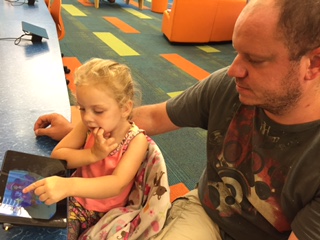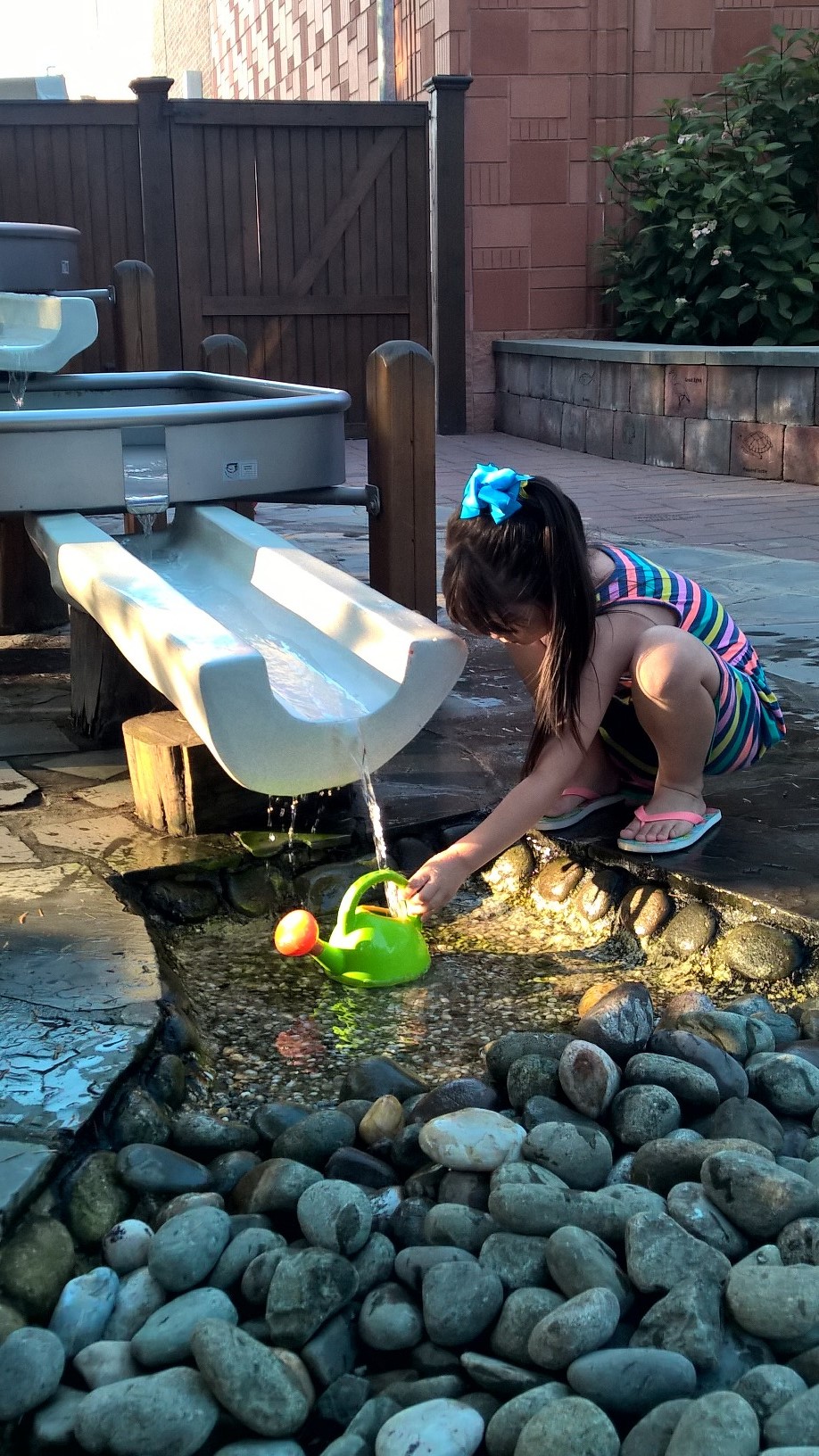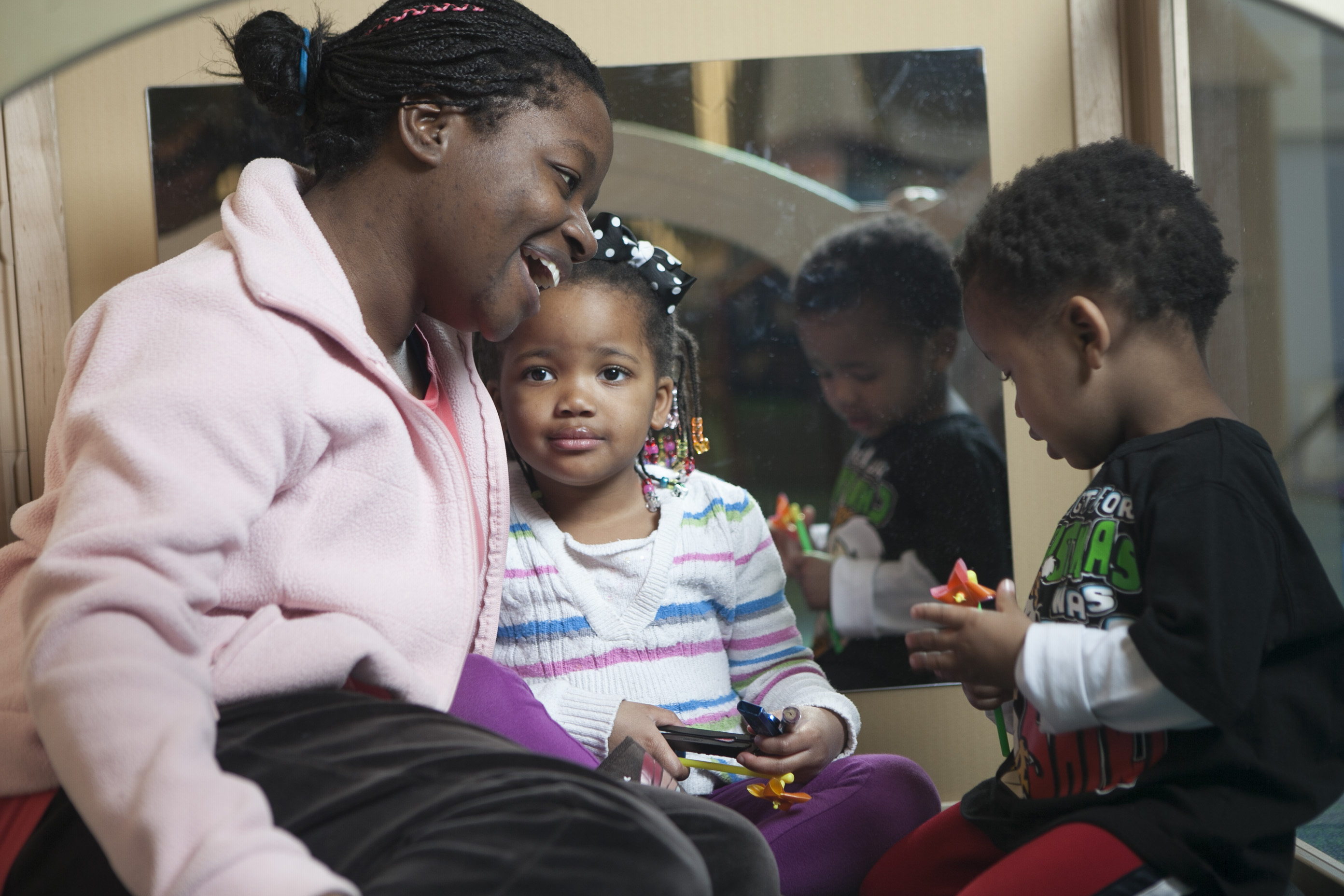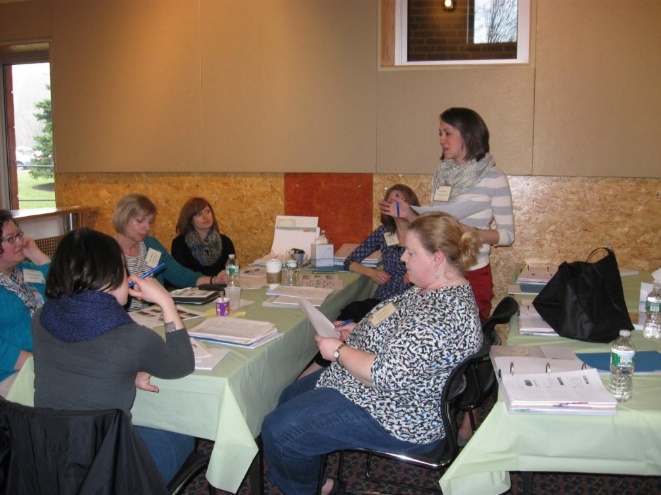The Harvard Family Research Project separated from the Harvard Graduate School of Education to become the Global Family Research Project as of January 1, 2017. It is no longer affiliated with Harvard University.
August 2016
Family Place Libraries
FINE Newsletter, Volume VIII, Issue 3
Issue Topic: Family Engagement in Children’s Learning Through Libraries
A toddler is at the sink filling a kettle with water for tea while his preschool sister sets the table, taking great care to ensure the colors of the plates, cups, and spoons all match. Across the room, a mom counts the cardboard blocks her 18-month-old is stacking and cheers as he uses his whole body to knock them down. Nearby, a 3-year-old and his dad are at the train table pushing and pulling the cars over and under the bridges; a family is reading and acting out We’re Going on a Bear Hunt while a friendly librarian models for a caregiver how to share a book with an infant; standing near book stacks, a librarian provides information on early intervention services for a parent concerned about her child’s development. These are typical scenes in a Family Place Library.
 |
|
| ------ | Digital media are an important component of early childhood library collections. Middle Country Library’s digital media spaces are designed intentionally so that families and children can explore apps together. |
 |
|
| Middle Country Library brings learning outdoors through the Nature Explorium, where children can garden, build, draw, and experiment with water. |
|
 |
|
| Family Place Libraries promote parent-child relationships by giving parents and children access to developmentally appropriate toys and activities, and by modeling ideas and ways parents can use materials to encourage children’s learning. |
|
 |
|
| Family Place Libraries staff provide training for librarians and community educators in a variety of topics, including family support, child development, coalition building and outreach. |
|
Family Place Libraries is a nationwide network of librarians who are trained in the Family Place Library approach, which builds on the knowledge that good health, early learning, parental involvement, and supportive communities play a critical role in young children’s growth and development. Currently in more than 450 libraries in 29 states, Family Place Libraries provide rich, engaging opportunities for anytime, anywhere learning for very young children and their parents and caregivers.
THE CORE COMPONENTS OF FAMILY PLACE LIBRARIES
Middle Country Public Library in Centereach, New York (Long Island), serves as the national model and training center for Family Place Libraries. Staff from each Family Place site participate in a comprehensive Training Institute and receive post-training support in implementing and sustaining this initiative. Core components of Family Place Libraries are listed below. While each of these components is important on its own, the Family Place Libraries model strives to weave them together into one coherent and comprehensive system.
- Collections of books, open-ended toys, music, and multimedia materials for babies, toddlers, parents, and service providers.
- A specially designed, welcoming space within the children’s area for families with young children that features all the collections mentioned above. Toys and board books are housed on low shelves, allowing even the youngest child to crawl over and self-select items to explore. Comfortable seating for parents and caregivers enables them to observe and participate in children’s play, make friends with and share parenting experiences and concerns with other families, and conveniently browse the parenting materials in the space.
The library also features an outdoor Nature Explorium, an interactive outdoor learning space for children and families that offers a unique way to connect literacy, learning, and an appreciation for nature. The Nature Explorium contains a variety of areas for investigation—messy materials, building, nature art, music and performance, planting, reading, and a water feature—all geared toward connecting children to a different aspect of nature.
- Programming for parents and children together. Parent/Child Workshop is a five-week program that involves toddlers and their parents and caregivers, emphasizing the role of parent as the child’s first teacher. Each week a local professional specializing in child development, nutrition, speech/hearing and language development, movement and play, or early literacy talk individually with parents, answering specific questions and concerns as the parents engage in play with their children. Family Place also helps libraries put in place developmentally appropriate programming for very young children and their parents, such as Baby Bump (for expectant moms), Baby Massage, Baby Rhyme Time, Toddlers Explore, and Sensory Storytimes.
- Coalition building with community agencies that serve families and young children to connect parents to community resources and develop programs and services tailored to meet local needs. This coalition building also serves as a way to reach out to new and nontraditional library users, who may not feel comfortable or even know about library services for families with babies and toddlers.
- Training for library staff in family support, child development, parent education, outreach, coalition building, early learning space development, developmentally appropriate programs, and best practices.
PROGRAM IMPACT
Findings from independent evaluations, as well as from internal reports and surveys, show that the Family Place model makes a difference for children, families, and libraries themselves.
- Children with delays and special needs are being identified early and connected with early intervention services.
- Families who participate in Family Place Libraries report feeling less isolated and a sense of community belonging, become better informed about library and community resources, and describe spending more time talking, reading, playing, and singing with their little ones.
- Libraries credit the model with having a positive impact on library staff and culture. A recent evaluation report prepared for the Institute of Museum and Library Services showed the model helps transform libraries into welcoming, family-friendly, early learning environments.
Whether located in urban, suburban, or rural communities, Family Place Libraries become vital community centers. They build connections among community families, support the role of parents and caregivers as children’s first teachers, provide rich opportunities for anytime, anywhere learning, increase chances for successful early intervention, and foster a lifelong love of reading and learning. One dad’s comment after participating in Family Place Libraries activities captures what many parents have communicated about their experiences, “This changed my relationship with my child, with other children, and other parents. I’m so grateful.”
SNAPSHOT Contributors:
Kathleen Deerr is the national coordinator for Family Place Libraries. She has presented at numerous library and early childhood conferences, authored books and articles including the Family-Centered Library Handbook, and trained over 600 librarians in implementing research-based early childhood and family support library services.
Margaret Caspe is a senior research analyst with Harvard Family Research Project.
RELATED RESOURCES:
This resource is part of the August 2016 FINE Newsletter. The FINE Newsletter shares the newest and best family engagement research and resources from Harvard Family Research Project and other field leaders. To access the archives of past issues, please visit www.hfrp.org/FINENewsletter. To subscribe to the FINE Newsletter, please visit our subscription center.
|
SEND US YOUR SNAPSHOTS! If you’re doing something that you think others should know about, we invite you to send us a description with a photo or short video to fine@gse.harvard.edu with the subject line: SNAPSHOTS. |

